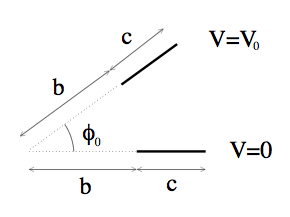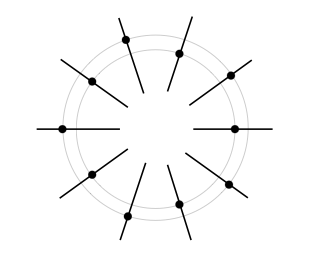EM M01 1
From QED
Two identical plates of length c and width d are separated by an angular separation of φ0, and the nearest point on each plate is a distance b from the origin. The plate at φ = 0 is grounded, and the plate at φ = φ0 is set at potential V .
a. Compute the stored energy in the capacitor. Assume that the electrical potential between the plates depends only on φ, and ignore fringe fields. (In which limit is this an allowed approximation?).
Now take ten plates in a cylindrical arrangement, and connect the odd plates together with one wire, and the even plates with another. There is no direct connection between the odd and even plates. Assume a charge Q is placed on the even plates, and a charge -Q on the odd plates.
b. Compute the total capacitance of this structure.
Since the potential Φ depends only on the angle φ, the general solution for the potential will be:
To fit the boundary conditions, we then have:

We can then find the electric field:

So that:

The surface charge density is given by the electric field:

So the total charge on one plate is given by:

and so the stored energy is:

The approximation will be valid for small φ (so that
there is no dependence on ρ) and for  (to neglect edge effects).
(to neglect edge effects).
From part a:

So that:

The capacitance is then, using φ0 = π / 5:

Since we have ten plates, we then get:

(One can think of this as each even plate having charge 2Q at voltage V, since it is charged on both sides, and then counting 5 of these plates and plugging into part a).
This page was recovered in October 2009 from the Plasmagicians page on Prelim_M01_EM1 dated 02:09, 13 August 2006.














